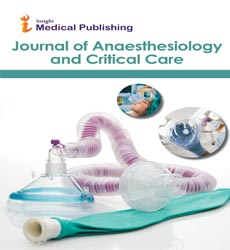Continuous Non-invasive Blood Pressure Measurement
Van Geel M*
Department of Cardiology and Cardiovascular Research Institute Basel, University of São Paulo Medical School, São Paulo, Brazil
- *Corresponding Author:
- Van Geel M
Department of Cardiology and Cardiovascular Research Institute Basel, University of São Paulo Medical School, São Paulo, Brazil
E-mail: vangeel@gmail.com
Received Date: November 26, 2021; Accepted Date: December 10, 2021; Published Date:December 17, 2021
Citation: Van Geel M (2021) Continuous Non-invasive Blood Pressure Measurement. J Anaesthesiol Crit Car. Vol.4 No.3:14
The digital revolution is about to bring physiologic monitoring innovations. Innovative wearable sensors for monitoring cardiovascular dynamics have the potential to revolutionise vital sign monitoring and therapy response in both ambulatory and in-hospital clinical settings. Continuous real-time monitoring of cardiovascular dynamics, including arterial blood pressure (BP) and advanced hemodynamic variables derived from its waveform (stroke volume, cardiac output (CO), and dynamic cardiac preload variables), is a mainstay of patient care in perioperative and intensive care medicine, but it still necessitates invasive or stationary noninvasive sensors. With the availability of noninvasive and wearable sensors, advanced cardiovascular monitoring could become a standard part of patient surveillance on regular wards and even outside the hospital. Upgrading patient monitoring capabilities with wearable solutions designed for general wards may aid in avoiding intensive care unit overload.
Wearable sensors must meet all regulatory and clinical requirements for medical-grade devices in order to be used in these clinical applications, just like their stationary counterparts. Future developments in the field of wearable miniaturised monitoring sensors will face challenges in providing clinically acceptable accuracy, precision, and reliability, as well as ensuring clinical usability and patient safety. Miniaturized monitoring sensors should ideally measure in the background without requiring user intervention. Wearable sensors for continuous blood pressure monitoring currently have poor measurement performance and, as a result, have not been adopted into clinical practise.
The majority of current wearable blood pressure monitoring systems estimate blood pressure based on time data. The pulse transit time or pulse arrival time is measured using a proximal and a distal sensor in pulse time interval or pulse velocity methods. Other time-based BP estimation methods employ sensors that decompose the pulse into a forward and a backward wave and analyse the time differences between them. There have also been attempts to estimate blood pressure using photoplethysmographic (PPG) or piezoelectric pulse detection based on amplitude and time information. However, due to the confounding effects of the cardiovascular, respiratory, and autonomic nervous systems, a direct translation of the pulse signal—which is a surrogate for volume changes—into continuous BP is difficult. The measurement performance of these approaches may be improved by increasing model complexity (e.g., by using machine learning and neural network tools). Despite the fact that their sensor hardware is very simple, significant effort is required to achieve clinically acceptable performance. The difficulty with time-based approaches for wearable BP measurement devices appears to be that the mathematical model variables must change in tandem with changes in vasomotor activity of the vascular smooth muscles, which is determined by the autonomic nervous system. All of this cuff-less attempts at continuous BP monitoring, such as using cuff-based sphygmomanometers, necessitate frequent re-calibration, making them unsuitable for wearable wireless monitoring.
Other wearable approaches based on the oscillometric principle provide BP readings on an irregular basis. The HeartGuide (Omron, Kyoto, Japan) is a wrist-worn watch-type oscillometric BP monitoring device, for example. Another novel method is to measure oscillometric curves by pressing a finger on the screen of a cell phone. While this study shows that oscillometric BP measurement at the finger is possible, these methods require user interaction (such as keeping the sensor at heart level or pressing a finger on the screen), and automated continuous BP monitoring (including monitoring during sleep) is not possible.
Stationary finger cuff devices have been introduced successfully for direct continuous noninvasive BP monitoring in a variety of medical fields, particularly critical care and anesthesiology. These devices rely on the vascular unloading technique (VUT), also known as volume clamping or the Peáz method. The VUT measures blood pressure and generates the complete pulsatile blood pressure waveform by controlling the fast inflation and deflation of a finger cuff in conjunction with PPG. The VUT, like time-based technologies, is affected by changes in vasomotor activity; different devices have developed different methods for detecting and compensating for changes in vasomotor tone.
VUT devices do not always require calibration to function properly. Instead, the Finapres (Ohmeda Monitoring Systems, Englewood, CO, USA) and successor devices estimate brachial BP values using a heart level sensor and/or a transfer function. CNAP (CNSystems Medizintechnik, Graz, Austria) devices take a different approach: they routinely use an upper arm cuff for orthostatic/heart level correction and calibration to brachial BP level. A transfer function approach is also used as a temporary correction until the calibration is performed or if the user prefers not to use the upper arm cuff.
Existing VUT systems, on the other hand, are too bulky to be used for wearable monitoring devices because they rely on mechanical elements such as pumps, valves, and air hoses to accurately track the pulsatile nature of blood pressure.
It was widely assumed that for accurate BP measurement based on VUT, a constant (or clamped) blood volume in the finger over the entire period of pulsation was required, as was full vascular unloading of the blood vessels. Whether or not this is physiologically or metrologically necessary was never investigated.
Open Access Journals
- Aquaculture & Veterinary Science
- Chemistry & Chemical Sciences
- Clinical Sciences
- Engineering
- General Science
- Genetics & Molecular Biology
- Health Care & Nursing
- Immunology & Microbiology
- Materials Science
- Mathematics & Physics
- Medical Sciences
- Neurology & Psychiatry
- Oncology & Cancer Science
- Pharmaceutical Sciences
